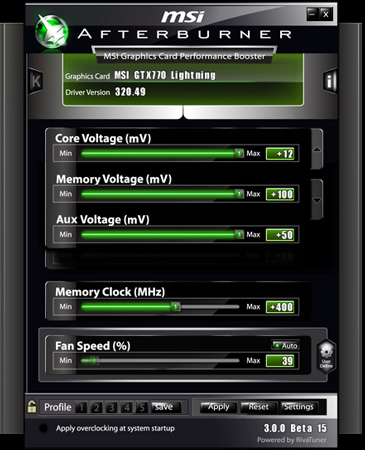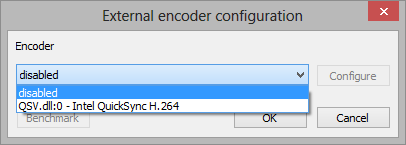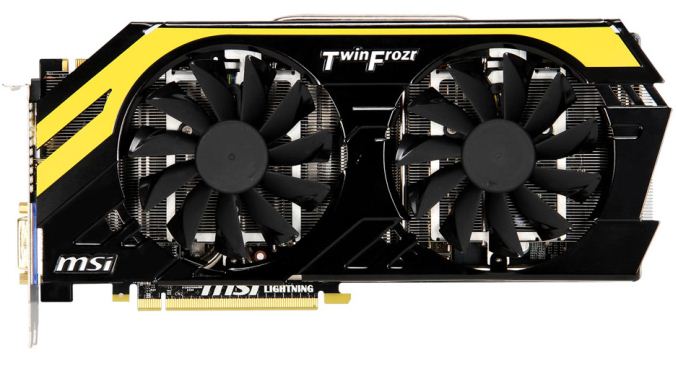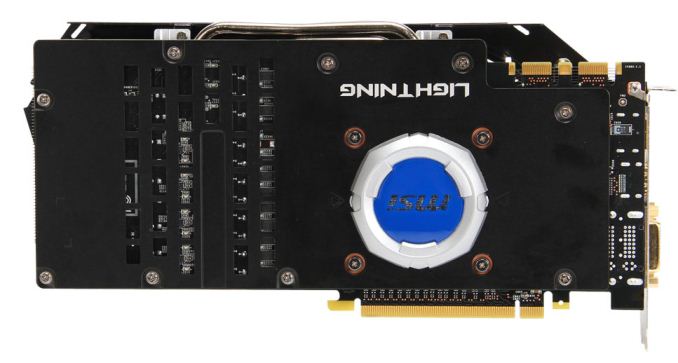The GeForce GTX 770 Roundup: EVGA, Gigabyte, and MSI Compared
by Ryan Smith on October 4, 2013 9:00 AM ESTMSI GTX 770 Lightning
The final card in our roundup is MSI’s GTX 770 Lightning. Lightning is MSI’s imprint for overclocking friendly cards, representing MSI’s best, most overbuilt products, designed to be competitive for the highest overclocks for any given video card family. In practice most buyers won’t end up engaging in the extreme overclocking MSI has designed the Lighting series for, but that still means that the resulting cards are solid and well built.
For the GTX 770 Lightning, alongside MSI’s vast suite of customizations the company is also shipping the card with a factory overclock, the highest such overclock of all of the cards in today’s roundup. At 1150MHz the GTX 770 Lightning is 104MHz (10%) over a stock GTX 770, however like the other factory overclocked GTX 770s features no memory overclock to speak of. The fact that these cards are already using 7GHz memory puts everyone in a bind in this respect, including MSI.
Going by design and construction, the GTX 770 Lightning stands alone in that regard. MSI has designed the card for extreme overclocking, which is heavily reflected in the design of the custom PCB. Meanwhile MSI’s custom Twin Frozer cooler, though not quite as extreme, is no slouch either.
The one downside in this setup, and we may as well mention it right away, is that while MSI has overbuilt this card for extreme overclocking, they’re technically not allowed to offer that functionality to the public as per NVIDIA’s Greenlight program. Greenlight requires that MSI is limited to the same 1.212v GPU limit that everyone else is also limited to, and while MSI can unlock this card for specific parties such as the competitive overclockers they work with, they cannot do so for the public at large. As a result the card’s significant overclocking abilities are not available without resorting to 3rd party software hacks or modified BIOSes, which although outside the scope of this article should do the trick.
Moving on, we’ll start with MSI’s custom PCB. The aforementioned work MSI has done to gear this card for extreme overclocking lies primarily in the board itself, which is where MSI has put in significant effort into customizing for the higher voltages and wattages necessary to achieve those clockspeeds. Right off the bat MSI is using 12 VRM phases for the GPU as opposed 5 on the reference GTX 770. The number of phases alone isn’t going to mean much at stock, but again for the extreme overclocking levels MSI is shooting for they will help provide the necessary power while spreading out the work of doing so over more components. For component selection MSI is using their Military Class IV branded components, which are composed of copper based MOSFETs (CopperMOS), a mix of high conductivity tantalum-based capacitors (Hi-c CAP) and traditional solid capacitors (Dark Solid CAP), and the company’s gold plated solid chokes (Golden SSC). Even the PCB itself goes a step beyond, coming in at about an inch higher than a standard PCIe card to fit all of MSI’s components.
Augmenting the base design are a few extra aspects related to the board. Having apparently run out of space on both the front and the back of the card, MSI rounds out their already extensive power delivery system with a further set of capacitors loaded on a separate PCB dubbed the GPU Reactor. The GPU Reactor is mounted to the back of the card and including the plastic cover juts out about half of an inch (which admittedly likely isn’t PCIe legal). The rest of the backside of the board is covered by a backplate that provides protection for the components MSI has loaded on the back of the PCB, though it’s not connected to any of these components so atypically there’s no cooling aspect to this design.
At the top of the card MSI has installed a BIOS switch, which is connected to a pair of BIOS banks. The idea behind the switch is that the second (non-default) BIOS is for extreme overclocking, however again due to the limitations imposed by NVIDIA it’s functionally no different than the first BIOS. However this does mean that BIOS flashing is protected on this card, as there’s always another BIOS to fall back on, which makes installing 3rd party modified BIOSes a much safer task. Meanwhile at the tail end of the card are MSI’s typical voltage monitoring points, offering the ability to hook up multimeter leads to directly measure the GPU, memory, and PLL voltages.
Moving on we have MSI’s Twin Frozer IV cooler, which provides the default cooling for the card. As implied by the name, the Twin Frozer is another dual fan cooler, with MSI employing a pair of large, 95mm fans to drive airflow over the card. These dual fans in turn cool MSI’s one-segment aluminum heatsink, which runs the full length of the card. 5 aluminum heatpipes provide thermal transfer between the GPU core and the heatsink, while an aluminum baseplate covers much of the card, providing heat transfer for the VRAM and various discrete components, while also providing rigidity to the card. The complete card is 11 inches long.
Supplying the interface to MSI’s extensive overclocking features is the company’s Afterburner overclocking and monitoring software, which alongside EVGA’s Precision X is currently our gold standard for overclocking software. Along with MSI’s traditional clockspeed and voltage controls, Afterburner also gains some additional abilities to go with the GTX 770’s overclocking features, specifically the ability to control memory and AUX voltage. Memory voltage can be increased by up to 0.1v, while aux voltage can be increased by up to 0.05v. Of all the cards in our roundup these voltage controls are unique to the GTX 770.

On the other hand, due to the aforementioned restrictions by NVIDIA, GPU voltage is still locked to the same 1.212v as any other GTX 770 card. So while those other voltages can be adjusted, the most likely outcome is that it will be the GPU voltage holding the card back; like some of the GTX 770 Lightning’s other features, they’re primary meant for extreme overclockers. The GTX 770 Lightning does pick up one more advantage however: due to MSI’s higher quality power delivery system, they are allowed to ship the card at a higher TDP of 260W, versus 230W on a stock GTX 770. Coupled with this, the maximum power target on the card is 109%, allowing a further increase of 23W to 283W. So although GPU overclocking is going to be limited by the standard voltage limits, in TDP limited scenarios (both stock and overclocked) the GTX 770 Lightning has more TDP headroom than other GTX 770 cards.
Overclocking aside, Afterburner has learned one more trick since we’ve last seen it: hardware accelerated encoding for its built in video recording functionality. Although first popularized by NVIDIA back at the launch of the GTX 780 with the premature announcement of Shadow Play, MSI has beaten NVIDIA to the punch by working in hardware accelerated encoding on their own in Afterburner. The end result is that Afterburner is capable of using Intel’s QuickSync H.264 encoder to do real time encoding, a first for a video capture utility of this nature. Unfortunately our GPU testbed is a Sandy Bridge-E system – and therefore lacking QuickSync – so we weren’t able to test it, but the reports we’ve seen do look promising.

Moving on, like the other cards in this roundup MSI implements NVIDIA’s standard display I/O configuration of 2x DL-DVI, 1x HDMI, and 1x DisplayPort 1.2. As an added perk of being MSi’s top tier GTX 770 card, they’ve gone and gold plated the I/O connectors for corrosion resistance. Meanwhile, the power delivery side of matters MSI has gone with an 8pin + 8pin external PCIe power connector configuration, once more going above and beyond what’s generally necessary for extreme overclocking.
Wrapping things up, the GTX 770 Lightning comes with a slightly unusual warranty policy. The card itself has a 3 year warranty for parts, but the labor is only for 2 years, effectively giving the card a 2 year warranty, a year shorter than the other cards in our roundup. At the same time the GTX 770 Lightning does demand a price premium the other cards do not, due to the fact that it’s not just a factory overclocked card, but a heavily beefed up specialty overclocking card. $435 after rebate gets you a 10% factory overclock, the highest factory overclock of the GTX 770 cards we’ve looked at, and for those striding into the danger zone, the possibility of some significant (and unsupported) GPU overvoltage.




















55 Comments
View All Comments
gandergray - Friday, October 4, 2013 - link
Ryan: Thank you for the quality review. From time to time, AT includes a table that shows relative performance and pricing of GPUs in AMD's and nVidia's GPU offerings. Would you include such table in this article?Ryan Smith - Friday, October 4, 2013 - link
Those tables are typically only used in what we consider "primary" reviews.For reviews and roundups of individual cards like this, we are less interested in how it compares to competitive cards, and more interested in how the reviewed products compare to other cards in the same product family. E.G. we've previously established how GTX 770 compares to 7970 and the like, but how do the individual 770 cards stack up?
BlakKW - Saturday, October 5, 2013 - link
Thanks for the review Ryan. I understand your reasoning for not including wider comparisons. For me, however, I always read GPU articles with an eye to "what does this mean for me?"...specifically, how is my 7950 boost holding up. I could wish for a better memory, I could open another tab and spend a few minutes pulling up past reviews...and I could wish that round-up and capsule reviews threw in a couple old charts (no reviewer comment or analysis needed), perhaps as an addendum titled "gpu overview" or "the big picture".Two games, one favoring AMD and one Nividia, would be great... or even a link to past charts for convenience. Anyway, great reviews...this isn't really a criticism, its just something I would like to see...
Ryan Smith - Saturday, October 5, 2013 - link
For something like that we have Bench. You can compare any cards we have in our results database, and it always contains the latest data we have collected.http://www.anandtech.com/bench/GPU13/
BlakKW - Saturday, October 5, 2013 - link
nice...never noticed that feature beforeGBHans - Sunday, November 3, 2013 - link
Ryan, how did you increase the max boost voltage from 1.2 to 1.212v? (Which app). I use afterburner but even though I move the voltage adjuster to 1.212, it reports at 1.2v.Btw, I picked up the 4gb version of the evga 770 (FTW) based on this review & the memory over clocks you saw, and it too is reaching 8+ghz on the memory.
And, yes, your Bench comparison tool is great and quite helpful.
neaoon - Monday, October 7, 2013 - link
hyyyyyneaoon - Monday, October 7, 2013 - link
I just want to add my story. I get paid over $87 per hour working online with Google! I work two shifts 2 hours in the day and 2 in the evening. And whats awesome is Im working from home so I get more time with my kids. Its by-far the best job I’ve had. I follow this great link >>>> uttr.it/ukvczrqFlunk - Friday, October 4, 2013 - link
Your comments about software from MSI, Evga and Gigabyte are a little strange as there is nothing at all stopping you from using any of their overclocking software on any of the cards mentioned. I use MSI Afterburner on my other branded cards all the time, it even works on laptops.jordanclock - Friday, October 4, 2013 - link
The point is that this software is part of what you're paying for when you purchase these cards. It's part of the value of the whole package. You could easily swap the heatsinks and fans, but those are still valid points to raise when reviewing the product as a whole.